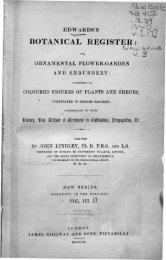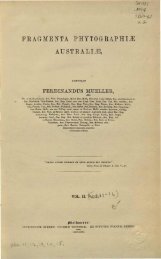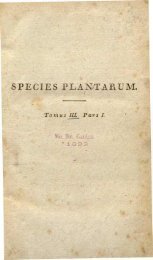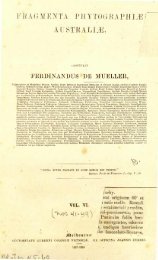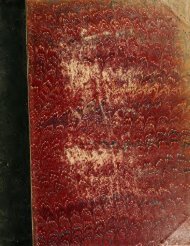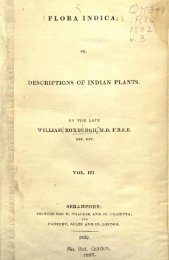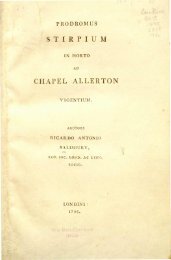Botanical Magazine 106 - 1880.pdf - hibiscus.org
Botanical Magazine 106 - 1880.pdf - hibiscus.org
Botanical Magazine 106 - 1880.pdf - hibiscus.org
You also want an ePaper? Increase the reach of your titles
YUMPU automatically turns print PDFs into web optimized ePapers that Google loves.
TAB. 6477.<br />
MAXILLARIA PORPHYROSTELE.<br />
Native of South Brazil.<br />
Nat. Oíd. OECHIDEíE.•Tribe VANDEJE.<br />
Genus MAXILLAKIA, Ruiz et Pav. ; {Lindl. Gen. et Sp. Orchid, p. 150.)<br />
MAXILLAKIA (Uniflora') porphvrostele ; acaulis, pseudobulbis ovoideo-orbiculatis<br />
compressis subsulcatis lateribus obtusis, foliis 2 ligulatis obtusis basi angus-<br />
tatis, seapis radicalibus 1-floris, bracteis vaginantibus viridibus subacutis inferné<br />
imbricatis supremo subcueullato obtuso ovarium subaequante, sepalis subacutis<br />
incurvis stramineis dorsali oblongo vix fornicato, lateralibus subdeflexis basi<br />
latioribus, petalis angustioribus ascendentibus incurvis linearibus subacutis<br />
stramineis medio basin versus purpurascente, mentó obtuso, labello trilobo, lobis<br />
lateralibus auricul•formibus erectis marginibus incurvis aureis purpureo striatis,<br />
intermedio orbiculari-oblongo obtuso planiusculo basi callo tuberculaeformi<br />
aucto pallide áureo, columna purpurea.<br />
M. porpbyrostele, Reichb.f. in Gard. Chron. 1873, p. 978.<br />
A native of the Rio Grande de Sul province of Brazil,<br />
whence it was imported by Mr. Bull, with whom it first<br />
flowered in 1873. Its nearest ally is the M. pida, Hook.,<br />
figured at Tab. 3154 of this work, a native of the Organ<br />
Mountains (Rio de Janeiro), and which differs in the pseudo-<br />
. bulbs, fewer bracts, and in the colouring of the much larger<br />
very sweet-scented flowers. Both belong to the largest<br />
section of the genus, many of which have a good deal the<br />
habits of Indian C•logynes, which genus Maxillaria in<br />
some respects represents in America. Reichenbach describes<br />
the pseudo-bulbs of this species as covered with numerous<br />
wrinkles, which not being the case in the specimen here<br />
figured, is probably due to a want of ripening, or to a too<br />
advanced state of that <strong>org</strong>an, which in a healthy condition<br />
is perfectly smooth. The flowers, which are copiously pro-<br />
duced, have no scent, but owing to their bright golden<br />
colour the plant is a very attractive one. The specimen<br />
figured is from a plant about a foot in diameter, which is<br />
covered with flowers in the early months of the year.<br />
DESCE. Pseudo-bulbs one inch long and hardly so broad,<br />
EEBBÜAEY 1ST, 1880.




